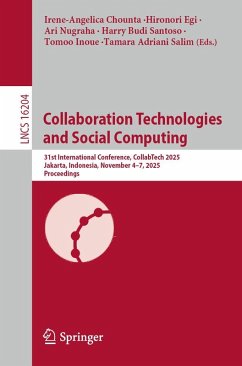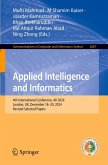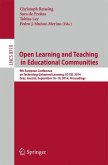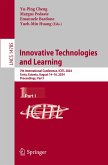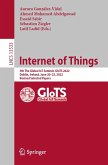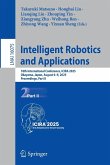Collaboration Technologies and Social Computing
31st International Conference, CollabTech 2025, Jakarta, Indonesia, November 4-7, 2025, Proceedings
Herausgegeben:Chounta, Irene-Angelica; Egi, Hironori; Nugraha, Ari; Budi Santoso, Harry; Inoue, Tomoo; Adriani Salim, Tamara
Collaboration Technologies and Social Computing
31st International Conference, CollabTech 2025, Jakarta, Indonesia, November 4-7, 2025, Proceedings
Herausgegeben:Chounta, Irene-Angelica; Egi, Hironori; Nugraha, Ari; Budi Santoso, Harry; Inoue, Tomoo; Adriani Salim, Tamara
- Broschiertes Buch
- Merkliste
- Auf die Merkliste
- Bewerten Bewerten
- Teilen
- Produkt teilen
- Produkterinnerung
- Produkterinnerung
This book constitutes the proceedings of the 31st International Conference on Collaboration Technologies and Social Computing, CollabTech 2025, held in Jakarta, Indonesia, during November 4 7, 2025.
The 12 full and 8 short papers presented in this volume were carefully reviewed and selected from 50 submissions.
They are grouped into the following topics: Collaborative Learning and Group Interaction; Technology-Mediated Communication and Online Environments; AI in Education: LLMs and Content Generation; Social Interaction, Community and Public Spaces; Systems for Supporting Discourse and Understanding. …mehr
Andere Kunden interessierten sich auch für
![Applied Intelligence and Informatics Applied Intelligence and Informatics]() Applied Intelligence and Informatics113,99 €
Applied Intelligence and Informatics113,99 €![Flexible Query Answering Systems Flexible Query Answering Systems]() Flexible Query Answering Systems44,99 €
Flexible Query Answering Systems44,99 €![Open Learning and Teaching in Educational Communities Open Learning and Teaching in Educational Communities]() Open Learning and Teaching in Educational Communities38,99 €
Open Learning and Teaching in Educational Communities38,99 €![Innovative Technologies and Learning Innovative Technologies and Learning]() Innovative Technologies and Learning57,99 €
Innovative Technologies and Learning57,99 €![Internet of Things Internet of Things]() Internet of Things85,59 €
Internet of Things85,59 €![Highlights in Practical Applications of Agents, Multi-Agent Systems and Computational Social Science. The PAAMS Collection Highlights in Practical Applications of Agents, Multi-Agent Systems and Computational Social Science. The PAAMS Collection]() Highlights in Practical Applications of Agents, Multi-Agent Systems and Computational Social Science. The PAAMS Collection65,99 €
Highlights in Practical Applications of Agents, Multi-Agent Systems and Computational Social Science. The PAAMS Collection65,99 €![Intelligent Robotics and Applications Intelligent Robotics and Applications]() Intelligent Robotics and Applications63,99 €
Intelligent Robotics and Applications63,99 €-
-
-
This book constitutes the proceedings of the 31st International Conference on Collaboration Technologies and Social Computing, CollabTech 2025, held in Jakarta, Indonesia, during November 4 7, 2025.
The 12 full and 8 short papers presented in this volume were carefully reviewed and selected from 50 submissions.
They are grouped into the following topics: Collaborative Learning and Group Interaction; Technology-Mediated Communication and Online Environments; AI in Education: LLMs and Content Generation; Social Interaction, Community and Public Spaces; Systems for Supporting Discourse and Understanding.
The 12 full and 8 short papers presented in this volume were carefully reviewed and selected from 50 submissions.
They are grouped into the following topics: Collaborative Learning and Group Interaction; Technology-Mediated Communication and Online Environments; AI in Education: LLMs and Content Generation; Social Interaction, Community and Public Spaces; Systems for Supporting Discourse and Understanding.
Produktdetails
- Produktdetails
- Lecture Notes in Computer Science 16204
- Verlag: Springer, Berlin; Springer; Springer Nature Switzerla
- Artikelnr. des Verlages: 89553722
- Seitenzahl: 292
- Erscheinungstermin: 31. Oktober 2025
- Englisch
- Abmessung: 235mm x 155mm x 16mm
- Gewicht: 447g
- ISBN-13: 9783032101556
- ISBN-10: 3032101557
- Artikelnr.: 75513582
- Herstellerkennzeichnung
- Springer-Verlag KG
- Sachsenplatz 4-6
- 1201 Wien, AT
- ProductSafety@springernature.com
- Lecture Notes in Computer Science 16204
- Verlag: Springer, Berlin; Springer; Springer Nature Switzerla
- Artikelnr. des Verlages: 89553722
- Seitenzahl: 292
- Erscheinungstermin: 31. Oktober 2025
- Englisch
- Abmessung: 235mm x 155mm x 16mm
- Gewicht: 447g
- ISBN-13: 9783032101556
- ISBN-10: 3032101557
- Artikelnr.: 75513582
- Herstellerkennzeichnung
- Springer-Verlag KG
- Sachsenplatz 4-6
- 1201 Wien, AT
- ProductSafety@springernature.com
.- Collaborative Learning and Group Interaction.
.- Facilitating Smooth Rejoining in Face-to-Face Group Chats by Sharing
Common Conversational Information after Temporary Absence.
.- Research on Switching Learning Tasks According to Fatigue Levels to
Accom modate Possibility of Interaction.
.- Social Interactions and Online Engagement in CSCL Environments:
Examining a Measurement Scale.
.- Estimating Discussion State from Head Movements in Collaborative
Learning Environments.
.- Self-Selected Groups vs. Random Groups: An Analysis of Student
Engagement, Achievement, and Preferences in Collaborative Learning.
.- Technology-Mediated Communication and Online Environments.
.- What Makes Turn-Taking Smooth? Analysis of Gaze Behavior during a Multi
tasking Videoconference.
.- A Proposal and Evaluation for Externalizing Thoughts of Passive Speakers
in Three-party Video Conferences with Gaze Tracking Functionality.
.- Temporal Analysis of User Engagement, Technology Trends and Emotional Dy
namics on Stack Overflow.
.- Do You See What I See? Vocal Cues to Visual Acuity Discrepancies in
VR-Based Stargazing.
.- AI in Education: LLMs and Content Generation.
.- Simulating Collaborative Learning with Data-Driven LLM Agents.
.- Evaluation of LLM-based Feedback Generation for Distance Project-Based
Learning.
.- Generating Vicarious Dialogue for Online Learning Using Knowledge
GraphBased Retrieval-Augmented Generation.
.- Social Interaction, Community and Public Spaces.
.- Dynamic Analysis of Social Capital in Commercial Areas Using Connection
Networks.
.- Emotional Analysis of Excluded Person Using Review Texts.
.- Public Quest: A Communication Game to Foster Understanding and
Relationships in Public Space.
.- How Do People Use Others’ and Their Own Traces in Free Exploration?.
.- Systems for Supporting Discourse and Understanding.
.- A System for Extracting Discussion Topics Worth Deeper Exploration.
.- Exploring the potential of hackathons as a means to promote
understanding of
AI literacy: a case study.
.- Supporting Time-Constrained Student Sports Journalists: Smartwatch
Flagging
and Match Visualization for Better Interview Questions.
.- Structural Analysis of Rebuttals to Evaluate Argumentative Interaction
in Par liamentary Debates.
.- Facilitating Smooth Rejoining in Face-to-Face Group Chats by Sharing
Common Conversational Information after Temporary Absence.
.- Research on Switching Learning Tasks According to Fatigue Levels to
Accom modate Possibility of Interaction.
.- Social Interactions and Online Engagement in CSCL Environments:
Examining a Measurement Scale.
.- Estimating Discussion State from Head Movements in Collaborative
Learning Environments.
.- Self-Selected Groups vs. Random Groups: An Analysis of Student
Engagement, Achievement, and Preferences in Collaborative Learning.
.- Technology-Mediated Communication and Online Environments.
.- What Makes Turn-Taking Smooth? Analysis of Gaze Behavior during a Multi
tasking Videoconference.
.- A Proposal and Evaluation for Externalizing Thoughts of Passive Speakers
in Three-party Video Conferences with Gaze Tracking Functionality.
.- Temporal Analysis of User Engagement, Technology Trends and Emotional Dy
namics on Stack Overflow.
.- Do You See What I See? Vocal Cues to Visual Acuity Discrepancies in
VR-Based Stargazing.
.- AI in Education: LLMs and Content Generation.
.- Simulating Collaborative Learning with Data-Driven LLM Agents.
.- Evaluation of LLM-based Feedback Generation for Distance Project-Based
Learning.
.- Generating Vicarious Dialogue for Online Learning Using Knowledge
GraphBased Retrieval-Augmented Generation.
.- Social Interaction, Community and Public Spaces.
.- Dynamic Analysis of Social Capital in Commercial Areas Using Connection
Networks.
.- Emotional Analysis of Excluded Person Using Review Texts.
.- Public Quest: A Communication Game to Foster Understanding and
Relationships in Public Space.
.- How Do People Use Others’ and Their Own Traces in Free Exploration?.
.- Systems for Supporting Discourse and Understanding.
.- A System for Extracting Discussion Topics Worth Deeper Exploration.
.- Exploring the potential of hackathons as a means to promote
understanding of
AI literacy: a case study.
.- Supporting Time-Constrained Student Sports Journalists: Smartwatch
Flagging
and Match Visualization for Better Interview Questions.
.- Structural Analysis of Rebuttals to Evaluate Argumentative Interaction
in Par liamentary Debates.
.- Collaborative Learning and Group Interaction.
.- Facilitating Smooth Rejoining in Face-to-Face Group Chats by Sharing
Common Conversational Information after Temporary Absence.
.- Research on Switching Learning Tasks According to Fatigue Levels to
Accom modate Possibility of Interaction.
.- Social Interactions and Online Engagement in CSCL Environments:
Examining a Measurement Scale.
.- Estimating Discussion State from Head Movements in Collaborative
Learning Environments.
.- Self-Selected Groups vs. Random Groups: An Analysis of Student
Engagement, Achievement, and Preferences in Collaborative Learning.
.- Technology-Mediated Communication and Online Environments.
.- What Makes Turn-Taking Smooth? Analysis of Gaze Behavior during a Multi
tasking Videoconference.
.- A Proposal and Evaluation for Externalizing Thoughts of Passive Speakers
in Three-party Video Conferences with Gaze Tracking Functionality.
.- Temporal Analysis of User Engagement, Technology Trends and Emotional Dy
namics on Stack Overflow.
.- Do You See What I See? Vocal Cues to Visual Acuity Discrepancies in
VR-Based Stargazing.
.- AI in Education: LLMs and Content Generation.
.- Simulating Collaborative Learning with Data-Driven LLM Agents.
.- Evaluation of LLM-based Feedback Generation for Distance Project-Based
Learning.
.- Generating Vicarious Dialogue for Online Learning Using Knowledge
GraphBased Retrieval-Augmented Generation.
.- Social Interaction, Community and Public Spaces.
.- Dynamic Analysis of Social Capital in Commercial Areas Using Connection
Networks.
.- Emotional Analysis of Excluded Person Using Review Texts.
.- Public Quest: A Communication Game to Foster Understanding and
Relationships in Public Space.
.- How Do People Use Others’ and Their Own Traces in Free Exploration?.
.- Systems for Supporting Discourse and Understanding.
.- A System for Extracting Discussion Topics Worth Deeper Exploration.
.- Exploring the potential of hackathons as a means to promote
understanding of
AI literacy: a case study.
.- Supporting Time-Constrained Student Sports Journalists: Smartwatch
Flagging
and Match Visualization for Better Interview Questions.
.- Structural Analysis of Rebuttals to Evaluate Argumentative Interaction
in Par liamentary Debates.
.- Facilitating Smooth Rejoining in Face-to-Face Group Chats by Sharing
Common Conversational Information after Temporary Absence.
.- Research on Switching Learning Tasks According to Fatigue Levels to
Accom modate Possibility of Interaction.
.- Social Interactions and Online Engagement in CSCL Environments:
Examining a Measurement Scale.
.- Estimating Discussion State from Head Movements in Collaborative
Learning Environments.
.- Self-Selected Groups vs. Random Groups: An Analysis of Student
Engagement, Achievement, and Preferences in Collaborative Learning.
.- Technology-Mediated Communication and Online Environments.
.- What Makes Turn-Taking Smooth? Analysis of Gaze Behavior during a Multi
tasking Videoconference.
.- A Proposal and Evaluation for Externalizing Thoughts of Passive Speakers
in Three-party Video Conferences with Gaze Tracking Functionality.
.- Temporal Analysis of User Engagement, Technology Trends and Emotional Dy
namics on Stack Overflow.
.- Do You See What I See? Vocal Cues to Visual Acuity Discrepancies in
VR-Based Stargazing.
.- AI in Education: LLMs and Content Generation.
.- Simulating Collaborative Learning with Data-Driven LLM Agents.
.- Evaluation of LLM-based Feedback Generation for Distance Project-Based
Learning.
.- Generating Vicarious Dialogue for Online Learning Using Knowledge
GraphBased Retrieval-Augmented Generation.
.- Social Interaction, Community and Public Spaces.
.- Dynamic Analysis of Social Capital in Commercial Areas Using Connection
Networks.
.- Emotional Analysis of Excluded Person Using Review Texts.
.- Public Quest: A Communication Game to Foster Understanding and
Relationships in Public Space.
.- How Do People Use Others’ and Their Own Traces in Free Exploration?.
.- Systems for Supporting Discourse and Understanding.
.- A System for Extracting Discussion Topics Worth Deeper Exploration.
.- Exploring the potential of hackathons as a means to promote
understanding of
AI literacy: a case study.
.- Supporting Time-Constrained Student Sports Journalists: Smartwatch
Flagging
and Match Visualization for Better Interview Questions.
.- Structural Analysis of Rebuttals to Evaluate Argumentative Interaction
in Par liamentary Debates.

